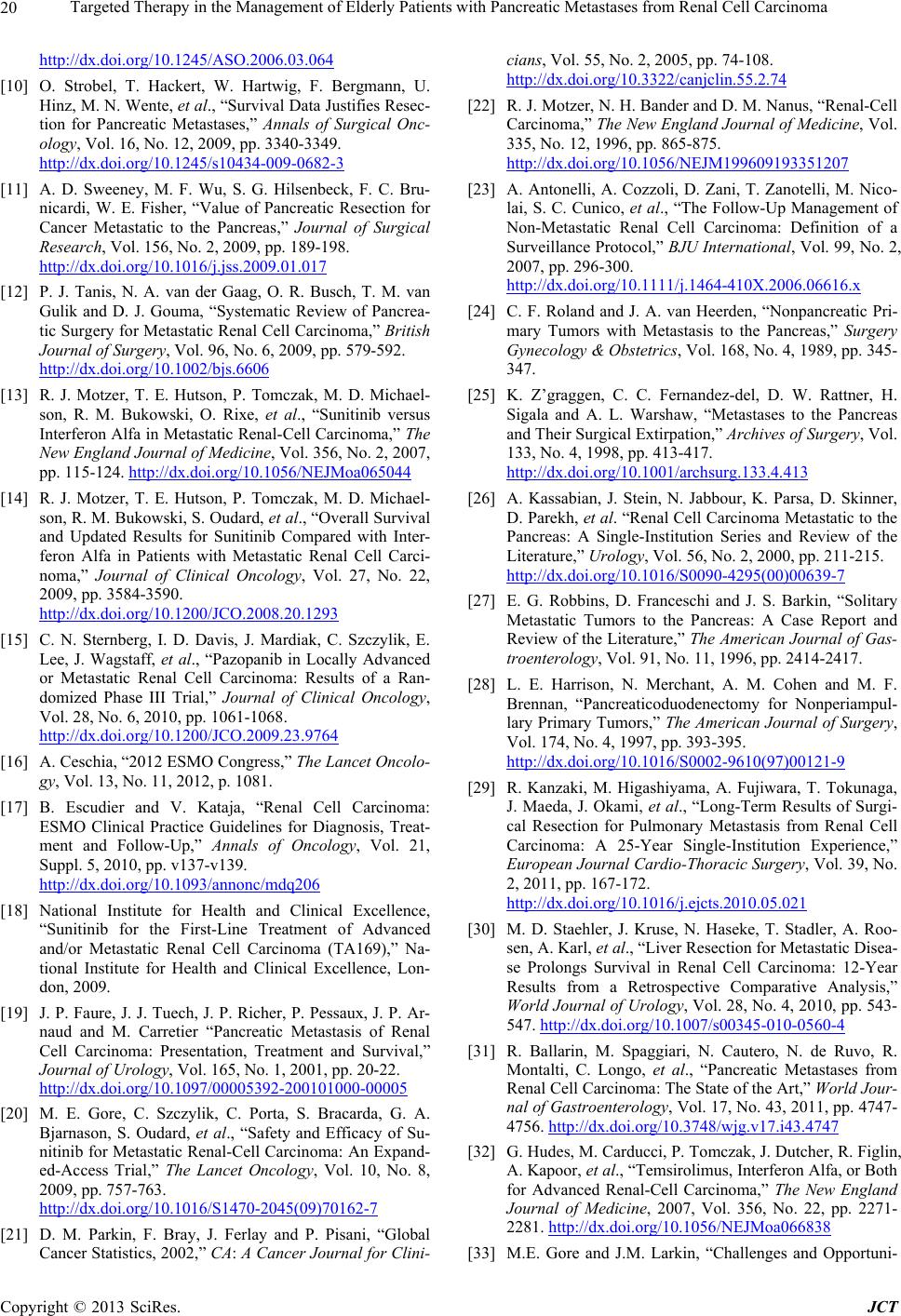
Targeted Therapy in the Management of Elderly Patients with Pancreatic Metastases from Renal Cell Carcinoma
20
http://dx.doi.org/10.1245/ASO.2006.03.064
[10] O. Strobel, T. Hackert, W. Hartwig, F. Bergmann, U.
Hinz, M. N. Wente, et al., “Survival Data Justifies Resec-
tion for Pancreatic Metastases,” Annals of Surgical Onc-
ology, Vol. 16, No. 12, 2009, pp. 3340-3349.
http://dx.doi.org/10.1245/s10434-009-0682-3
[11] A. D. Sweeney, M. F. Wu, S. G. Hilsenbeck, F. C. Bru-
nicardi, W. E. Fisher, “Value of Pancreatic Resection for
Cancer Metastatic to the Pancreas,” Journal of Surgical
Research, Vol. 156, No. 2, 2009, pp. 189-198.
http://dx.doi.org/10.1016/j.jss.2009.01.017
[12] P. J. Tanis, N. A. van der Gaag, O. R. Busch, T. M. van
Gulik and D. J. Gouma, “Systematic Review of Pancrea-
tic Surgery for Metastatic Renal Cell Carcinoma,” British
Journal of Surgery, Vol. 96, No. 6, 2009, pp. 579-592.
http://dx.doi.org/10.1002/bjs.6606
[13] R. J. Motzer, T. E. Hutson, P. Tomczak, M. D. Michael-
son, R. M. Bukowski, O. Rixe, et al., “Sunitinib versus
Interferon Alfa in Metastatic Renal-Cell Carcinoma,” The
New England Journal of Medicine, Vol. 356, No. 2, 2007,
pp. 115-124. http://dx.doi.org/10.1056/NEJMoa065044
[14] R. J. Motzer, T. E. Hutson, P. Tomczak, M. D. Michael-
son, R. M. Bukowski, S. Oudard, et al., “Overall Survival
and Updated Results for Sunitinib Compared with Inter-
feron Alfa in Patients with Metastatic Renal Cell Carci-
noma,” Journal of Clinical Oncology, Vol. 27, No. 22,
2009, pp. 3584-3590.
http://dx.doi.org/10.1200/JCO.2008.20.1293
[15] C. N. Sternberg, I. D. Davis, J. Mardiak, C. Szczylik, E.
Lee, J. Wagstaff, et al., “Pazopanib in Locally Advanced
or Metastatic Renal Cell Carcinoma: Results of a Ran-
domized Phase III Trial,” Journal of Clinical Oncology,
Vol. 28, No. 6, 2010, pp. 1061-1068.
http://dx.doi.org/10.1200/JCO.2009.23.9764
[16] A. Ceschia, “2012 ESMO Congress,” The Lancet Oncolo-
gy, Vol. 13, No. 11, 2012, p. 1081.
[17] B. Escudier and V. Kataja, “Renal Cell Carcinoma:
ESMO Clinical Practice Guidelines for Diagnosis, Treat-
ment and Follow-Up,” Annals of Oncology, Vol. 21,
Suppl. 5, 2010, pp. v137-v139.
http://dx.doi.org/10.1093/annonc/mdq206
[18] National Institute for Health and Clinical Excellence,
“Sunitinib for the First-Line Treatment of Advanced
and/or Metastatic Renal Cell Carcinoma (TA169),” Na-
tional Institute for Health and Clinical Excellence, Lon-
don, 2009.
[19] J. P. Faure, J. J. Tuec h, J. P. Richer, P. Pessaux, J. P. Ar-
naud and M. Carretier “Pancreatic Metastasis of Renal
Cell Carcinoma: Presentation, Treatment and Survival,”
Journal of Urology, Vol. 165, No. 1, 2001, pp. 20-22.
http://dx.doi.org/10.1097/00005392-200101000-00005
[20] M. E. Gore, C. Szczylik, C. Porta, S. Bracarda, G. A.
Bjarnason, S. Oudard, et al., “Safety and Efficacy of Su-
nitinib for Metastatic Renal-Cell Carcinoma: An Expand-
ed-Access Trial,” The Lancet Oncology, Vol. 10, No. 8,
2009, pp. 757-763.
http://dx.doi.org/10.1016/S1470-2045(09)70162-7
[21] D. M. Parkin, F. Bray, J. Ferlay and P. Pisani, “Global
Cancer Statistics, 2002,” CA: A Cancer Journal for Clini-
cians, Vol. 55, No. 2, 2005, pp. 74-108.
http://dx.doi.org/10.3322/canjclin.55.2.74
[22] R. J. Motzer, N. H. Bander and D. M. Nanus, “Renal-Cell
Carcinoma,” The New England Journal of Medicine, Vol.
335, No. 12, 1996, pp. 865-875.
http://dx.doi.org/10.1056/NEJM199609193351207
[23] A. Antonelli, A. Cozzoli, D. Zani, T. Zanotelli, M. Nic o-
lai, S. C. Cunico, et al., “The Follow-Up Management of
Non-Metastatic Renal Cell Carcinoma: Definition of a
Surveillance Protocol,” BJU International, Vol. 99, No. 2,
2007, pp. 296-300.
http://dx.doi.org/10.1111/j.1464-410X.2006.06616.x
[24] C. F. Roland and J. A. van Heerden, “Nonpancreatic Pri-
mary Tumors with Metastasis to the Pancreas,” Surgery
Gynecology & Obstetrics, Vol. 168, No. 4, 1989, pp. 345-
347.
[25] K. Z’graggen, C. C. Fernandez-del, D. W. Rattner, H.
Sigala and A. L. Warshaw, “Metastases to the Pancreas
and Their Surgical Extirpation,” Archives of Surgery, Vol.
133, No. 4, 1998, pp. 413-417.
http://dx.doi.org/10.1001/archsurg.133.4.413
[26] A. Kassabian, J. Stein, N. Jabbour, K. Parsa, D. Skinner,
D. Parekh, et al. “Renal Cell Carcinoma Metastatic to the
Pancreas: A Single-Institution Series and Review of the
Literature,” Urology, Vol. 56, No. 2, 2000, pp. 211-215.
http://dx.doi.org/10.1016/S0090-4295(00)00639-7
[27] E. G. Robbins, D. Franceschi and J. S. Barkin, “Solitary
Metastatic Tumors to the Pancreas: A Case Report and
Review of the Literature,” The American Journal of Gas-
troenterology, Vol. 91, No. 11, 1996, pp. 2414-2417.
[28] L. E. Harrison, N. Merchant, A. M. Cohen and M. F.
Brennan, “Pancreaticoduodenectomy for Nonperiampul-
lary Primary Tumors,” The American Journal of Surgery,
Vol. 174, No. 4, 1997, pp. 393-395.
http://dx.doi.org/10.1016/S0002-9610(97)00121-9
[29] R. Kanzaki, M. Higashiyama, A. Fujiwara, T. Tokunaga,
J. Maeda, J. Okami, et al., “Long-Term Results of Surgi-
cal Resection for Pulmonary Metastasis from Renal Cell
Carcinoma: A 25-Year Single-Institution Experience,”
European Journal Cardio-Thoracic Surgery, Vol. 39, No.
2, 2011, pp. 167-172.
http://dx.doi.org/10.1016/j.ejcts.2010.05.021
[30] M. D. Staehler, J. Kruse, N. Haseke, T. Stadler, A. Roo-
sen, A. Karl, et al., “Liver Resection for Metastatic Disea-
se Prolongs Survival in Renal Cell Carcinoma: 12-Year
Results from a Retrospective Comparative Analysis,”
World Journal of Urology, Vol. 28, No. 4, 2010, pp. 543-
547. http://dx.doi.org/10.1007/s00345-010-0560-4
[31] R. Ballarin, M. Spaggiari, N. Cautero, N. de Ruvo, R.
Montalti, C. Longo, et al., “Pancreatic Metastases from
Renal Cell Carcinoma: The State of the Art,” World Jour-
nal of Gastroenterology, Vol. 17, No. 43, 2011, pp. 4747-
4756. http://dx.doi.org/10.3748/wjg.v17.i43.4747
[32] G. Hudes, M. Carducci, P. Tomczak, J. Dutcher, R. Figlin,
A. Kapoor, et al., “Temsirolimus, Interferon Alfa, or Both
for Advanced Renal-Cell Carcinoma,” The New England
Journal of Medicine, 2007, Vol. 356, No. 22, pp. 2271-
2281. http://dx.doi.org/10.1056/NEJMoa066838
[33] M.E. Gore and J.M. Larkin, “Challenges and Opportuni-
Copyright © 2013 SciRes. JCT